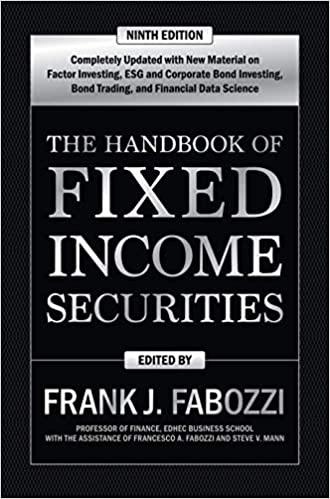1) Continuous markets differ from call markets in that Continuous markets are open twenty-four hours a day, seven days each week, call markets are only open during certain hours of certain days Continuous markets announce foxed clearing prices, call markets match buyers with sellers at various prices Continuous markets reflect prices based on order flow as much as supply and demand, call markets determine a market clearing price based on a collection of market orders Continuous markets are always price driven, call markets are always order driven 2) In a continuous market, orders are collected for the next auction event, which occurs at a foxed time during the day. 3) The LVRG Equity Fund has an expected return Eld of 8,030% and a standard deviation of 20%. The FIX Bond Fund has and expected return EN of 3.590% and a standard deviation of 8%. The correlation coefficient() is 0.07. A portfolio comprised of 27% LVRG and 73% FIX would have an expected return of and a standard deviation of 4) We expect a return on the market of 6.000% and a risk free rate of 3.400%. The beta of Tardis Intertemporal is measured over the past five years as 1.60. We therefore expect that Tardis tertemporal wil generate a return of and the risk premiums in this market is 5) American Depository Shares are negotiable receipts representing common stock of a foreign company held in trust by a foreign Bank where the shares are registered with the sung im as shareholders 6) Subscription rights in the securities market are Long-term rights to buy shares at a pored price given to employees as rewards for good service Short-term rights to buy shares at a fixed price given to existing shareholders Used to reward new investors who purchase shares in the offering Used to reward management for achieving corporate goals of growth and profitably 500 wanasemat www 5) American Depository Shares are negotiable receipts representing common stock of a foreign company held in trust by a foreign Bank where the shares are registered with the issuing firm as shareholders. 6) Subscription rights in the securities market are Long-term rights to buy shares at a faced price given to employees as rewards for good service Short-term rights to buy shares at a fixed price given to existing shareholders Used to reward new investors who purchase shares in the offering Used to reward management for achieving corporate goals of growth and profitability 7) Aunt Mabel promised to give you $5000 when you successfully complete your freshman year, $2000 when you successfully complete your sophomore year, $4000 when you successfully complete your junior year, and $6000 when you successfully complete your senior year. Aunt Mabel made this promise when you graduated from High School and let's assume you go directly to the University of Illinois and graduate in four years. Aunt Mabel expects the interest rates to be 5.750% during your freshman year, 1.250% during your sophomore year, 7.750% during your junior year, and 2.000% during your senior year. if Aunt Mabel can predict interest rates with accuracy, she will deposit to her bank account and after your freshman year her bank balance will be and after your sophomore year her bank balance will be and after your junior year her bank balance will be 8) $2,000,000.00 is invested at the beginning of May. On May 24 $80,000.00 is withdrawn from the account. At the end of May the account is worth $2,100,000.00. The cash-fow adjusted rate of return for May is 9) The Market Capitalization of a public corporation is a reference to the firm's market value based on the number of shares of stock outstanding times the market price per share








